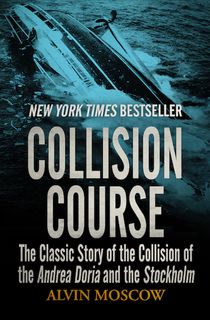Late at night on July 25th, 1956, two ocean liners struck each other just off the coast of Nantucket. Within several hours, one of them would lie at the bottom of the Atlantic—while the other, relatively unscathed, would continue sailing into the 21st century as a cruise ship.
On July 17th, the prized SS Andrea Doria departed from Genoa, Italy for one of its usual nine-day journeys to the United States. After making stops in France, Naples, and Gibraltar, she held roughly 1,700 guests and crew. Meanwhile, MS Stockholm was making the opposite voyage, as she embarked on a routine route from New York to Sweden. At the time, she was the smallest passenger liner on the North Atlantic—half the size of Andrea Doria, in fact—and carried 742 people the evening of the collision.

SS Andrea Doria, built in 1951, was one of Italy's most prized ocean liners after World War II.
Photo Credit: WikipediaAs day turned to night on July 25th, a heavy fog settled in. Andrea Doria and Stockholm were bound for one another in the same shipping corridor, with their captains none the wiser. Realization dawned far too late: Just minutes before the crash, the ships attempted to make a clean pass—but to no avail. Instead, the distance between Andrea Doria and Stockholm narrowed, making a collision inevitable.
Stockholm hit Andrea Doria at an almost perfect 90 degree angle just before midnight, ramming into five levels of passenger decks. Six first class guests died immediately, their suites obliterated by the other ship. Many of Andrea Doria's third class passengers—mostly Italians—were also killed. Others would meet similar fates in the following hours, until Andrea Doria’s death toll reached a total of 46 people. The casualties aboard Stockholm were less significant—five crew members died overall—and the ship itself remained afloat.

SS Andrea Doria lies on her side after the collision.
Photo Credit: WikipediaAndrea Doria did not sink for another 11 hours, giving the crew and guests enough time to seek refuge on boats that had responded to their distress calls. Stockholm suffered minor damages in comparison, and it even took 500 Andrea Doria passengers to safety. But while thousands of lives were saved, the crash ranked alongside the sinking of the RMS Titanic as one of the worst maritime disasters of the 20th century.
The New York Times bestseller Collision Course explores the ins and outs of the fatal crash, explaining its causes and devastating aftermath. Author Alvin Moscow, a former Associated Press journalist, also goes beyond the event itself, following the subsequent trial that determined who was at fault for the tragedy. The following excerpt of Moscow’s book takes readers into a scene of utter chaos, as Andrea Doria’s passengers learn of the collision and begin to react.
Click here to read an excerpt of Collision Course, and then download the book.
This post is sponsored by Open Road Media. Thank you for supporting our partners, who make it possible for The Archive to continue publishing the history stories you love.

